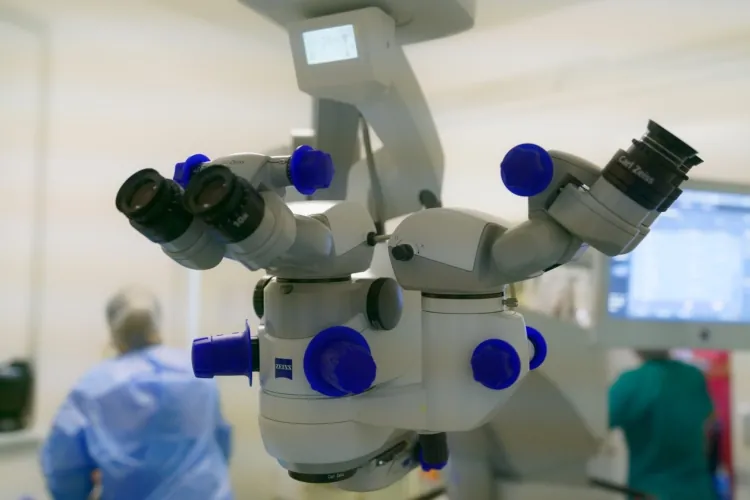Phacoemulsification (also known as Phaco surgery) is a step in the overall cataract surgery procedure. It’s a surgical procedure used to remove cataracts, a clouding of the lens in the eye that can cause blurry vision, sensitivity to light, and difficulty seeing at night.
This procedure is considered one of the safest and most effective treatments for cataracts and is commonly performed worldwide. But to help you understand more about the surgery, our experts will explore what Phacoemulsification is, and what you need to know about it when having cataract surgery.
Phaco surgery is extremely safe and effective

What is Phacoemulsification Surgery?
Phacoemulsification is a step in the cataract removal procedure. An ultrasonic device is used to break up (emulsify) the eye’s cloudy lens. The residue of the broken lens is then removed. Phacoemulsification is a quite minimally invasive technique, only requiring a small incision in the eye, through which the probe is inserted to perform the emulsification.
After this step, an artificial intraocular lens (IOL) is placed to restore your vision. Learn more about who qualifies for cataract surgery.
Step-By-Step Phaco Surgery Procedure:
Prior to your cataract surgery, which incudes phacoemulsification, your clinical care team will provide a thorough assessment pre operation assessment to ensure you are fit and well to undergo cataract surgery.
Anaesthetic: The patient is given a local anaesthetic to numb the eye and reduce any pain or discomfort during the procedure. Sedatives may also be administered to help the patient relax.
Incision: A tiny incision is made in the cornea, the clear front part of the eye.
Capsulotomy: A circular opening is made in the lens capsule, which is a thin membrane that surrounds the lens.
Phacoemulsification: A small probe is inserted through the incision and into the lens. The probe emits high-frequency ultrasound waves that break up the cloudy lens into small pieces, which are then suctioned out of the eye.
IOL Implant: Once the cloudy lens has been removed, an artificial lens, known as an intraocular lens (IOL), is inserted into the same lens capsule (bag) that holds the natural lens.
Closure: The technique performed means that the incision created is self-sealing.
The entire procedure typically takes approximately 8 minutes to complete and is performed on an outpatient basis, which means the patient can go home the same day.
Cataract surgery is an extremely safe and common procedure – the modern techniques at Optegra, coupled with our renowned surgeons means we boast high success rates, with 94% of our patients happy in recommending to family and friends.
Recovering from Phaco Surgery
Phacoemulsification is a safe and minimally invasive procedure with a low risk of complications. However, like any surgical procedure, there are some risks, including infection, bleeding, and damage to the cornea or other parts of the eye. These risks are relatively low, with infection rates estimated at less than 1%, and most complications are minor and can be treated effectively.
Patients typically experience little to some discomfort during the procedure and may also experience mild discomfort or irritation afterwards. Recovery time is relatively short, and patients can usually return to their normal activities within a few days. However, they will need to use eye drops for a few weeks to reduce inflammation and prevent infection.
Preparation:
Before the procedure, patients will need to undergo a comprehensive eye exam to determine the extent of the cataract and to assess the overall health of the eye.
Success Rates:
Phacoemulsification has a very high success rate, with more than 96% of patients experiencing improved vision after the procedure.
Phacoemulsification Recovery Tips
As phacoemulsification surgery is a step within the cataract removal procedure, patients should follow the following cataract surgery tips: Take prescribed meds diligently. Prescribed medicated eye drops will help prevent infection and reduce inflammation. Use these exactly as described by your clinical care team.
- Avoid touching your eyes: It increases the risk of infection and can slow down healing.
- Protect your eyes: Wearing sunglasses or a protective shield helps to avoid contact with your eyes. Learn why sunglasses can prevent cataracts in our guide.Avoid strenuous activities: Refrain from heavy activities like weights or exercise for at least a week after surgery. It can increase the risk of complications and bleeding.
- Avoid water exposure: Avoid swimming or getting water in your eyes for at least two weeks after surgery, as this can increase the risk of serious infection.
- Attend follow-up appointments: This ensures that your eyes are healing properly and allows you to address any concerns you have about your recovery.
- Have a family member or friend take you home. Vision may be slightly blurry immediately after treatment, so it is wise to have someone take you home or have transport prearranged.
Get in Touch Today!
To learn how our five-star hospitals and clinics can help you with your cataract issues and help you restore your vision, why not get in touch for a free virtual consultation with our one of our leading experts?

By Author: Amir Hamid
Mr. Amir Hamid is a Clinical Lead for Vision Correction and an expert refractive surgeon, based in London.
Medically Reviewed Date: 7th November 2024
